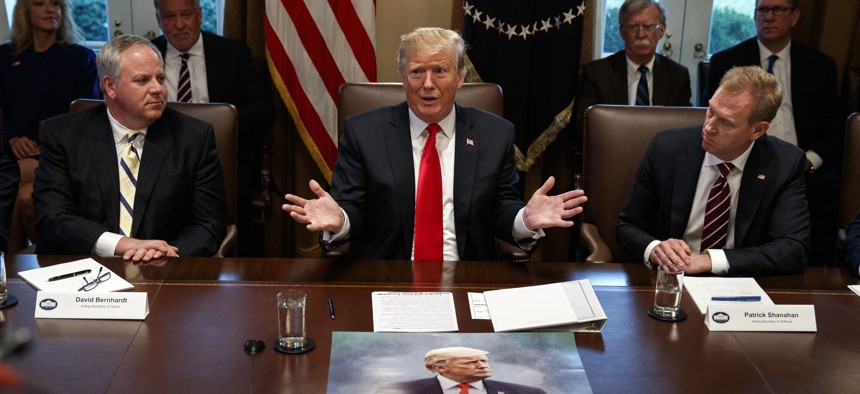
President Donald Trump speaks during a cabinet meeting at the White House, Wednesday, Jan. 2, 2019, with acting Defense Secretary Patrick Shanahan, right. AP Photo/Evan Vucci
Trump Just Killed His Own Defense Strategy
The commander in chief has torn up 17 years of counterterrorism plans, offering instead his strange mix of talking points and lies.
“Sand and death.” That’s what Syria is to President Donald Trump, who has vowed to withdraw U.S. troops and support for America’s partners in the war-torn country.
Afghanistan apparently is not worth much more to him. At a Wednesday cabinet meeting, the president said he was happy to let the Taliban and ISIS fight each other without American troops in their way.
That’s what Trump wants. He scoffed at “the generals” who want U.S. troops to fight them both, as they do at the request of Afghanistan, alongside the Afghan security forces the U.S. has spent 17 years building up. Trump did not mention what the Syrians or Afghans wanted for themselves. He did not reveal what his past or incoming defense secretaries, Joint Chiefs, or combatant commanders wanted, other than they wanted to stay and fight alongside their partner forces.
Related: Trump Escalates His Assault on Civil-Military Relations
Related: Goodbye, Mattis. Goodbye, Syria. Hello, 2019
Related: The ‘Nightmare Scenario’ Has Happened and You’re to Blame
After deferring to establishment national security advisors like Defense Secretary Jim Mattis, Chief of Staff John Kelly, and National Security Advisor H.R. McMaster for nearly two years, Trump has suddenly decided to stop. In the past month, he has rejected in part or whole the two most important ongoing U.S. military interventions in the world, scrapping the “South Asia strategy” he reluctantly announced in September 2017. Moreover, he has effectively torn up the National Defense Strategy, the plan to counter China and Russia that former Defense Secretary Jim Mattis approved just three months ago, presumably after his own White House’s review.
In place of these strategies, Trump offered his strange mix of talking points and lies.
“I mean, I'm the only person in the history of our country that could really decimate ISIS, say we're bringing the troops back home over a period of time — I never said so quickly, but over a period of time. But everybody gives me credit for decimating ISIS,” Trump said, as his cabinet listened in silence during the televised portion of their White House meeting.
“So we do that, and we say we're going to bring the troops back home, where they belong. I've been campaigning on that for a long time, before I won, a big part of my campaign: I want to bring our troops back from the endless wars. We have endless wars. They've been going on for 19 years in the area. But I'm going to bring them home from Syria.”
But nothing is that clear with this commander in chief. After his introductory ramble, Trump began answering reporters’ questions. Within moments, he contradicted himself, assuring that U.S. troops were neither completely leaving Syria, nor leaving too soon (“We're slowly bringing people back”), nor abandoning Kurdish partner forces. “We want to protect the Kurds,” he said, without saying how.
“We are continuing to fight. We never let anybody down. And there was a lot of misinterpretation, but I think you'll see at the end, that's working out,” Trump said, of U.S. military support for the Syrian Democratic Forces. “But what we're doing is the right thing to do. And in many respects, it's very exciting because I like winning. When I took over Syria, Syria was a mess.”
Trump continued, dismissing analysts who have argued that his withdrawal order benefits Russia and Iran. “They don’t like seeing us leave because we're knocking out ISIS. Let them fight ISIS too. We're spending all of this money. I want to spend money in our country.”
But it was Trump’s next line that was most jarring.
“Syria was lost long ago. It was lost long ago. And besides that we’re talking about sand and death. That’s what we’re talking about. We’re not talking about, you know, vast wealth. We’re talking about sand and death.”
In other words, by Trump’s logic, if Syria had more tangible wealth — he did not identify what, but presumably some resource that benefits the U.S. pocketbook — then it would be worth continuing to send troops into the lethal military mission there.
Wealth. Not power. Not strategic advantage. Not human rights. Not human life. Wealth.
Trump did not say that he saw in Syria a vital geopolitical location, or an unbelievable women’s movement or the seeds of true democracy sprouting amid the U.S. ground forces, or leverage toward a Geneva peace process on Syria’s political future to rewrite its constitution, end Bashar al-Assad’s regime, and create a U.S.-friendly Syria-Iraq axis that could be a bulwark to the Iranian regime’s regional hegemonic aspirations and from financing and arming terrorism.
Trump saw none of that. He saw “sand and death.”
The president’s remarks at his first Cabinet meeting of 2019 were more than another jaw-dropping stream-of-consciousness moment from the president. They were nothing less than a total rebuke of his administration’s defense strategy — and of the U.S. counterterrorism strategy of the past 17 years.
It’s over. Afghanistan, Syria, and the Pentagon’s years-old pillar of fighting counterterrorism abroad, where it lives and breathes, is over.
Trump and his supporters have said the president is only doing what he promised two years ago on the campaign trial. But he promised two completely different things. He promised to defeat terrorism, and also to bring troops home. Both are not possible simultaneously, and the first one is supposed to happen first. Special operations commanders in Syria said before Trump even took office that they worried he would not have the patience for their plans to build foreign fighters into proxy, professional armies and forces. Their fears are being born out.
If the United States is facing greater strategic competition, a breakdown of international rules and order, and threats more volatile and complex than ever, wouldn’t it want to have forward-deployed military and diplomatic armies — à la “peace through strength” of Ronald Reagan — wherever they needed to be? As Trump’s own National Defense Strategy proclaimed three months ago:
“We are facing increased global disorder, characterized by decline in the long-standing rules-based international order—creating a security environment more complex and volatile than any we have experienced in recent memory.”
That’s in the second paragraph of the NDS’s cover sheet. To be sure, the NDS shifts defense priorities from terrorism to geopolitical nation-states. But it prescribes a shift, not an abandonment. And in certain regions, especially in the Middle East, Trump’s plan says state power competition goes hand-in-hand with counterterrorism efforts.
If Iran is “destabilizing regions through their pursuit of nuclear weapons or sponsorship of terrorism,” as the NDS states a little further down, and “competing across all dimensions of power” by “asserting an arc of influence and instability while vying for regional hegemony, using state-sponsored terrorist activities, a growing network of proxies, and its missile program,” wouldn’t the U.S. want more power and influence in the region — not less — to check down Iran and protect and advance Washington’s own interests?
Put another way, the NDS offers a list of security goals. The U.S. military and diplomatic mission in Syria serves nearly all of them, including:
- Sustaining Joint Force military advantages, both globally and in key regions
- Deterring adversaries from aggression against our vital interests
- Enabling U.S. interagency counterparts to advance U.S. influence and interests
- Maintaining favorable regional balances of power in the Middle East
- Defending allies from military aggression and bolstering partners against coercion, and fairly sharing responsibilities for common defense
- Dissuading, preventing, or deterring state adversaries and non-state actors from acquiring, proliferating, or using weapons of mass destruction
- Preventing terrorists from directing or supporting external operations against the United States homeland and our citizens, allies, and partners overseas
Trump’s decision to withdraw ground troops ignores all of these. By asking Turkey to try to fill the void, critics have argued, Trump gives up a powerful American check on all of these threats.
Furthermore, according to the NDS, the U.S. aims to block Russia and Iran by occupying spaces like Syria so that they can’t. It says, “With our allies and partners, we will challenge competitors by maneuvering them into unfavorable positions, frustrating their efforts, precluding their options while expanding our own, and forcing them to confront conflict under adverse conditions.” With barely 2,500 U.S. troops alongside the SDF in Syria, the United States was doing all of those things.
Trump’s decision on Syria more clearly is his and his alone. He is farther removed from the strategic plans or visions advocated by his own administration and military leaders than was known. He is not pulling out of Syria to re-prioritize U.S. military resources. He has not said the troops are needed to fight more urgent threats elsewhere, or that the country can’t afford to pay for the operations, or that there was greater strategic value to withdrawing them. He said he likes better deals, meaning paying less money for missions abroad. Trump did suggest that Americans had fought enough, and that having U.S. adversaries fight each other over the same space of land may be a better move. Perhaps, but only if those enemies fight each other to the death. The Taliban and ISIS, in Afghanistan. Or ISIS, Assad, Russia, and Iran, in Syria. But eventually, one of those sides will win and rule either by force or by welcome partnership. But the United States will not be a player, partner, or, certainly, not a leader.
The National Defense Strategy that Mattis approved for Trump is not law. It’s a guidebook. Pentagon staffers note that it identifies three “lines of effort,” or objectives. One is “strengthening alliances as we attract new partners.” By abandoning Syria, Trump is doing the opposite.
Pentagon leaders will have to readjust to follow their commander in chief, quickly. U.S. allies are scrambling to decide whether to fill the American void abroad. The SDF and other U.S. partner forces already are choosing their least bad options, including aligning with Assad, the dictator who is aligned with Russia and Iran. Together they will fight ISIS, just as Trump wanted. And they will build a post-conflict future that benefits themselves, not the United States. Critics have written repeatedly that other nations and fighters are watching the U.S. closely and seeing just how long Washington’s commitment lasts. They are seeing just how good is an American commander’s word. Now they know. U.S. commanders and diplomats can make promises. But there’s only one commander in chief now: Donald Trump.
NEXT STORY: GOP Lawmakers: Shutdown Could Last for Weeks
